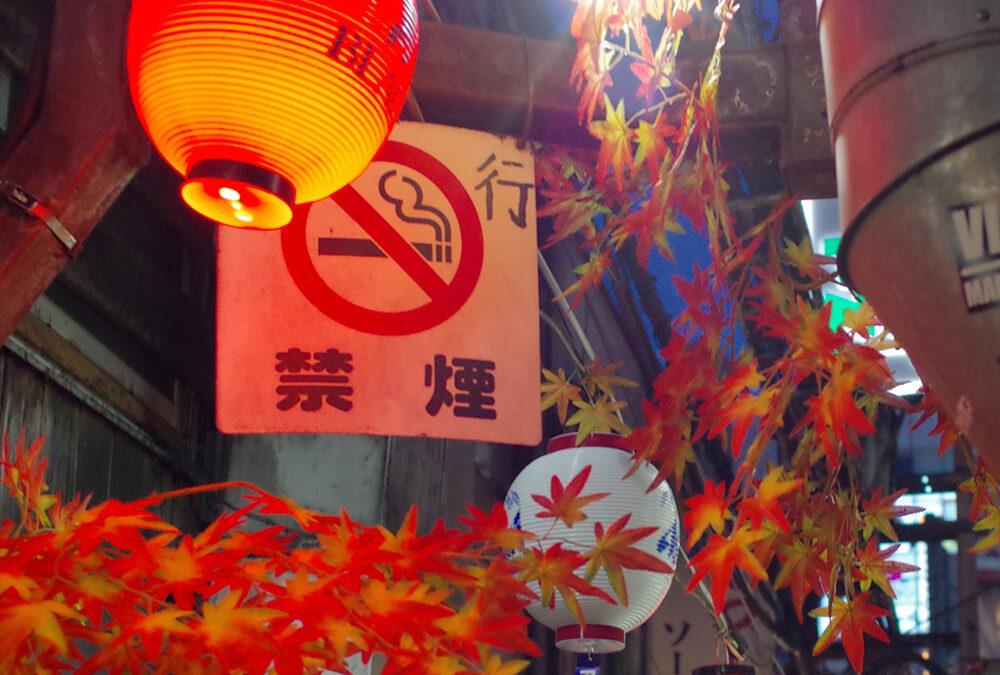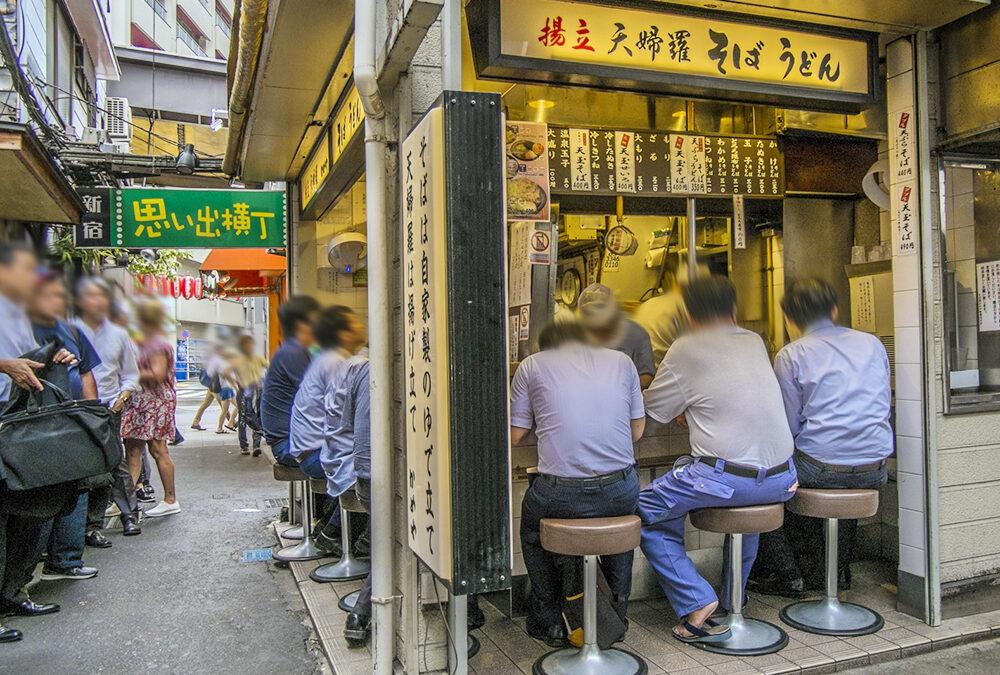Omoide Yokocho, often celebrated for its nostalgic appeal, has its origins in the post-war era, serving initially as a hub for entertainment bars and black market vendors under strict governmental commodity controls.
Its picturesque lanes, rich with history, were notably populated by yakitori and motsu (offal) stalls, leveraging the lack of regulation on animal innards to thrive.
The essence of experiencing Omoide Yokocho lies in wandering its alleys, immersing in the vibrant ambiance before choosing where to dine.
While many spots offer English menus, letting the atmosphere and visual appeal guide your choice enriches the experience.
Embodying a blend of historical charm and anticipation for the future, Omoide Yokocho invites visitors to revel in its storied past, with a subtle promise of more delights ahead.
If you’re searching for an izakaya tour in Omoide Yokocho, be sure to check out the Omoide Yokocho / Izakaya tour offered by Tokyo Travel Assist.
Essential Tips for Enjoying Omoide Yokocho
To truly embrace the vibrant atmosphere of Omoide Yokocho, consider strolling around to find shops that catch your eye and stepping inside to experience them firsthand.
It’s also a great idea to hop between two or three establishments to diversify your experience.
Since popular spots can run out of specialties early or get crowded quickly, aim to visit your chosen spots right at opening time if you have specific ones in mind.
Be mindful that operating hours and closed days vary from shop to shop, so researching this information beforehand is beneficial.
Some unique and popular shops worth checking out will be highlighted in the latter section.
Navigating the quaint alleyways with some rules

To fully enjoy your visit, it’s essential to be aware of a few local customs and rules.
Common bathroom
Firstly, an interesting aspect to note is that all shops along Nakadori Street, the main narrow path within Omoide Yokocho, share a communal bathroom facility.
This indicates that individual establishments do not have their own.
This facility received a comprehensive update in March 2021, introducing separate amenities for women and men and improved hand-washing facilities.
Cash-only payment
Despite its timeless charm, about 60% of the establishments in Omoide Yokocho still operate on a cash-only basis, reflecting the area’s traditional roots.
However, several shops do accept alternative payment methods such as credit cards and AliPay, though the majority primarily process payments through Japanese payment services.
Individual policies / guidelines
Each shop might follow its own set of rules regarding orders. You might encounter places that impose a table charge, require each guest to purchase both a drink and a meal upon entry, or set a 90-minute time limit for each party.
It’s wise to familiarize yourself with these policies beforehand to ensure a smooth experience.
No smoking on the street
Smoking regulations within Omoide Yokocho are also quite particular.
Following a significant fire on November 24, 1999, which resulted in the loss of a third of the area without any casualties, smoking is now restricted to specific establishments that permit it.
Understanding these guidelines will not only help you navigate the alleyways of Omoide Yokocho but also enhance your appreciation for this historic and nostalgic Tokyo spot.
7 Best Eateries at Omoide Yokocho
Below, some especially recommended shops will be introduced. Selected for their high ratings from locals, it’s noted that while some may lack English menus, the guarantee remains that the atmosphere, along with delicious drinks and dishes, can be thoroughly enjoyed.
Kabuto(カブト)
この投稿をInstagramで見る
Kabuto is a distinguished eel restaurant founded in 1948, specializing exclusively in eel.
It offers a rare opportunity to taste various parts of eel, from the head, back fin, belly fin, liver, to the tail, all grilled to perfection over Binchotan charcoal.
Binchotan is a high-quality white charcoal known for its ability to cook food evenly without imparting any unwanted flavors, ensuring a pure, smoky taste.
First-time visitors are required to order the “Hitotouri” set menu, featuring every part of the eel, with the option to order favorite parts à la carte afterwards.
Note that the set menu cannot be shared among diners.
Guests can enjoy a selection of beverages, including beer and shochu, under a policy that caps alcohol consumption at three drinks per person, regardless of type.
It reflects the owner’s commitment to ensuring that those who visit to savor the unique flavors don’t face lengthy waits.
Given Kabuto’s popularity and its tendency to fill up quickly upon opening, arriving early is advised.
The owner, who speaks only a little English and may not appear friendly, is dedicated to serving a high volume of customers single-handedly, focusing intently on his work.
| Name | Kabuto |
| Address | 1 Chome-2-11 Nishishinjuku, Shinjuku City, Tokyo 160-0023(Map) |
| Opening Hours | 13:00〜20:00 |
| Maximum seating capacity | 11 |
| Payment | Cash Only |
Horaiya(宝来家)
この投稿をInstagramで見る
Daini Horaiya, the first grilled offal restaurant in Omoide Yokocho, prides itself on a variety of skewers grilled over Binchotan charcoal and flavored with a secret sauce that has been perfected over the years, as well as the freshest premium offal sashimi.
The establishment is renowned for its delicious skewers and motsu nikomi (stewed offal), receiving high praise from patrons.
A seating charge applies. As smoking is allowed inside, those sensitive to cigarette smoke should be mindful.
Popular items include grilled offal, Gatsu (stomach), Hatsu (heart), and Kobukuro (uterus) sashimi.
While most staff do not speak English, they provide friendly and welcoming service.
Horaiya has two locations within Omoide Yokocho, with “Daini Horaiya” offering a greater number of seats.
| Name | Horaiya(宝来家) |
| Address | Daiichi Horaiya : 1 Chome−2−7, Nishishinjuku, Shinjuku City, Tokyo (Map) Daini Horaiya : 1 Chome-2-5 Nishishinjuku, Shinjuku City, Tokyo(Map) |
| Opening Hours | Daiichi Horaiya : 16:30 to 25:00 Irregular holidays Daini Horaiya : 15:30〜24:00 Sat14:30~23:00 Sun&Holiday 13:00~22:00 |
| Maximum seating capacity | 11 |
| Payment | Cash Only |
| Website | Daiichi Horaiya : http://horaiya.com/1/ Daini Horaiya : http://horaiya.com/2/ |
Motsuyaki Ucchan(もつ焼き ウッチャン)
この投稿をInstagramで見る
Motsuyaki Ucchan is a popular spot known for its grilled skewers and other dishes that pair perfectly with alcohol, often becoming fully seated right at opening.
The stars of the menu are the fresh “Motsuyaki,” grilled offal skewers, and “Nikomi,” a stew made with offal. “Motsu” refers to the internal organs of animals such as cattle, pigs, and chickens.
Historically, “Motsu” was called “Horumon” in the Kansai region, both terms indicating offal.
Motsuyaki involves skewering these parts and grilling them with salt or sauce, while Nikomi is a hearty stew flavored with soy sauce or miso, cooked with various ingredients.
The establishment is quite small, and their delectable food tends to sell out quickly, so arriving early is advisable.
| Name | Motsuyaki Ucchan(もつ焼き ウッチャン) |
| Address | 1 Chome-2-11 Nishishinjuku, Shinjuku City, Tokyo 160-0023(Map) |
| Opening Hours | 13:00〜20:00 |
| Maximum seating capacity | 11 |
| Payment | Cash Only |
Kameya(かめや)

Kameya is a stand-and-eat soba noodle shop, representing a type of fast food that has existed in Japan for a long time.
Soba noodle is a food made from the flour of buckwheat grains, kneaded with water and cut into thin, elongated strips.
It is typically eaten boiled, served with a dipping sauce or broth poured over it.
The concept of stand-and-eat soba dates back to the Edo period, originating from “Yotaka Soba” where leftover noodles were sold at night from stalls, and became widespread post-war.
Unlike typical stand-and-eat soba where customers stand at the counter to eat, Kameya offers seats for dining.
Their best-selling item is the tempura soba with Kakiage for 450 yen.
Kakiage is a type of tempura made with a mix of small pieces of seafood and vegetables, known for its satisfying size.
この投稿をInstagramで見る
Additionally, they offer soba topped with a soft-boiled egg among other dishes.
Kameya is known for its quick service, allowing customers to eat and leave promptly, facilitating a fast turnover of patrons.
| Name | Kameya(かめや) |
| Address | 1 Chome-2-10 Nishishinjuku, Shinjuku City, Tokyo(Map) |
| Opening Hours | 24h |
| Maximum seating capacity | 8 |
| Payment | Cash |
Asadachi(朝起)
この投稿をInstagramで見る
Asadachi, which translates to “morning wood,” offers a menu that features seasonal ingredients, with fish and shellfish selections changing daily.
The restaurant is known for its variety of rare delicacies, including frog, dojo loach, and soft-shelled turtle, in addition to a wide array of vegetable and meat dishes.
Notably, soft-shelled turtle is considered a vitality-boosting ingredient in Japan, which is believed to have inspired the restaurant’s name.
For those seeking a unique accompaniment to their meal, Habu snake liquor is available, also renowned for its vitality-boosting properties.
A reservation three days in advance is necessary for those wishing to enjoy Asadachi’s soft-shelled turtle hot pot.
| Name | Asadachi(朝起) |
| Address | 1 Chome-2-14 Nishishinjuku, Shinjuku City, Tokyo(Map) |
| Opening Hours | 13:00~24:00(L.O.23:30) |
| Maximum seating capacity | 18 |
| Payment | Cash |
Kitakata Ramen Bannai(喜多方ラーメン坂内)
この投稿をInstagramで見る
Kitakata Ramen Bannai is celebrated for offering the authentic flavors of Aizu Kitakata’s renowned gourmet dishes, such as “Shina Soba” and “Niku Soba” (meat soba).
Although “Soba” is mentioned, they do not refer to the Japanese soba described earlier.
Instead, they are types of Chinese-style noodles, also known as Ramen in Japanese, which are different from the soba noodles served at Kameya. (Yep, it’s confusing.)
Despite Aizu Kitakata being located in Japan’s Tohoku region, patrons can enjoy the genuine taste of these famous dishes at the Shinjuku store.
The ramen shop is famous for its exceptionally tender and melt-in-your-mouth chashu pork.
It offers a light soy sauce-based soup and traditionally serves thick noodles, though customers can opt for thin noodles as well.
この投稿をInstagramで見る
Orders are placed through a ticket vending machine, which customers then present to the staff.
| Name | Kitakata Ramen Bannai(喜多方ラーメン坂内) |
| Address | 1 Chome-2-8 Nishishinjuku, Shinjuku City, Tokyo(Map) |
| Opening Hours | 10:00〜23:30 |
| Maximum seating capacity | 8 |
| Payment | Cash |
Tajimaya coffee(但馬屋珈琲店)
この投稿をInstagramで見る
Tajimaya Coffee Shop welcomes you to a nostalgic setting that evokes the Taisho era, providing a traditional Japanese café, known as a “Kissaten(喫茶店),” where guests can unwind in comfort.
The café prides itself on its specialty coffee, brewed from house-roasted, darkly roasted beans using a flannel drip, resulting in an exceptionally delicious cup.
An English menu is available for non-Japanese speakers.
However, please be aware that smoking is permitted inside, which may not be comfortable for all guests.
The attention to detail extends to their drip coffee, meticulously prepared via flannel drip for a flavorful experience.
Additionally, the café’s sweets, including pudding and shortcake, have earned high praise for their quality.
| Name | Tajimaya coffee(但馬屋珈琲店) |
| Address | 1 Chome-2-6 Nishishinjuku, Shinjuku City, Tokyo(Map) |
| Opening Hours | 10:00~23:00 (L.O.22:30) |
| Maximum seating capacity | 45 |
| Payment | Cash / Transit IC Cards |
Explore More of Omoide Yokocho
The shops introduced above represent just a fraction of what Omoide Yokocho has to offer, with the alley boasting around 60 eateries in total.
For those interested in exploring all the options, the Omoide Yokocho official website provides detailed information on each establishment.
Additionally, TokyoTravelAssist offers izakaya tours focused on the eateries within Omoide Yokocho, which could be a great way to experience the area’s lively dining scene.
Consider checking them out for a comprehensive tour.
